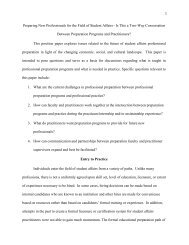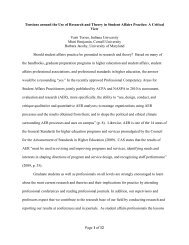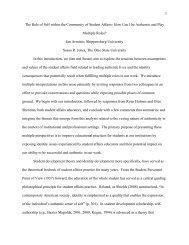Organizational Change as a Result of Campus Crisis
Organizational Change as a Result of Campus Crisis
Organizational Change as a Result of Campus Crisis
You also want an ePaper? Increase the reach of your titles
YUMPU automatically turns print PDFs into web optimized ePapers that Google loves.
Preparing for <strong>Campus</strong> Dis<strong>as</strong>ters:<br />
Best Practices and Suggested Steps<br />
Mahauganee D. Shaw<br />
Indiana University<br />
Lowell K. Davis, PhD<br />
The University <strong>of</strong> Alabama<br />
Presentation at the American College Personnel Association Annual Conference * Baltimore, MD * March 30, 2011
• Learn how campus crises are defined and cl<strong>as</strong>sified<br />
• Highlight examples <strong>of</strong> campus crises<br />
• Discuss best practices in campus crisis management<br />
• Discuss how preparation affects an institution’s ability to<br />
respond<br />
• Practice working through the crisis response process<br />
Objectives
DEFINING CAMPUS CRISES
Lerner, Volpe, & Lindell (2004) formally defined crisis <strong>as</strong> “a<br />
traumatic event that seriously disrupts our coping and problemsolving<br />
abilities”<br />
Seymour and Moore (2000) defined a crisis <strong>as</strong> a “disruption <strong>of</strong><br />
normal patterns <strong>of</strong> corporate activity by a sudden or overpowering<br />
and initially uncontrollable event” (p. 10).<br />
Zdziarski (2006) expanded the definition <strong>of</strong> crisis further <strong>as</strong> “an<br />
event, <strong>of</strong>ten sudden and unexpected, that disrupts the normal<br />
operations <strong>of</strong> the institution or its educational mission and threatens<br />
the well-being <strong>of</strong> personnel, property, financial resources, and/or<br />
reputation <strong>of</strong> the institution” (p. 5).<br />
What is a dis<strong>as</strong>ter or a<br />
crisis?
• Three considerations:<br />
• Level <strong>of</strong> crisis<br />
• Type <strong>of</strong> crisis<br />
• Intentionality*<br />
• Process <strong>of</strong> cl<strong>as</strong>sification guides the appropriate response<br />
Cl<strong>as</strong>sifying <strong>Campus</strong> <strong>Crisis</strong>
Critical<br />
Incident<br />
<strong>Campus</strong><br />
Emergency<br />
Dis<strong>as</strong>ter<br />
• Effects a segment <strong>of</strong> campus or a subgroup<br />
• Normal operations continue<br />
• Effects entire campus<br />
• Disrupts normal operations<br />
• Effects campus and surrounding community<br />
• Usual resources are delayed or unavailable<br />
Levels <strong>of</strong> <strong>Crisis</strong><br />
Zdziarski, Dunkel, Rollo, & Associates (2007)
Environmental<br />
Facility<br />
Human<br />
Types <strong>of</strong> <strong>Crisis</strong><br />
• Originates in the environment or<br />
nature<br />
• Example: earthquake, flood, hurricane<br />
• Originates in a facility or structure<br />
• Example: power outage, bldg. fire<br />
• Originates with or initiated by humans<br />
• Example: traffic accident, mental<br />
health issues, criminal acts<br />
Zdziarski, Dunkel, Rollo, & Associates (2007)
September 11 th<br />
Hurricanes Katrina, Rita, Wilma and Ike<br />
Virginia Tech M<strong>as</strong>sacre<br />
Floods in Iowa<br />
• What did your institution do after these events?<br />
• W<strong>as</strong> your campus prepared?<br />
• Are there other dis<strong>as</strong>ters that could impact your campus?<br />
Examples <strong>of</strong> Dis<strong>as</strong>ters
Post-<strong>Crisis</strong><br />
Ph<strong>as</strong>e<br />
Recovery<br />
Learning<br />
Response<br />
<strong>Crisis</strong> Ph<strong>as</strong>e<br />
Planning<br />
Prevention<br />
<strong>Crisis</strong> Management Cycle<br />
Reproduced from <strong>Campus</strong> <strong>Crisis</strong> Management (p. 47), by E. L. Zdziarski, II, J. M. Rollo, N. W. Dunkel, and Associates,<br />
San Francisco, CA: Jossey-B<strong>as</strong>s. Copyright 2007 by John Wiley & Sons, Inc.<br />
Pre-<strong>Crisis</strong><br />
Ph<strong>as</strong>e
Proactive <strong>Crisis</strong> Management<br />
Signal<br />
Detection<br />
Preparation<br />
/ Prevention<br />
<strong>Crisis</strong><br />
Learning<br />
Containment/<br />
Damage<br />
Limitation<br />
Interactive <strong>Crisis</strong> Management<br />
Reactive <strong>Crisis</strong> Management<br />
(“Cr<strong>as</strong>h Management”)<br />
Recovery<br />
<strong>Crisis</strong> Management Cycle<br />
Reproduced from Transforming the <strong>Crisis</strong>-Prone Organization (p. 135), by T. C. Pauchant and I.I. Mitr<strong>of</strong>f, 1992, San<br />
Francisco, CA: Jossey-B<strong>as</strong>s. Copyright 1992 by Jossey-B<strong>as</strong>s Inc.
PREPARING FOR CRISES
• Construct a representative <strong>Crisis</strong> Management Team<br />
• Access to information and resources<br />
• Individual skill sets<br />
• Group dynamics<br />
• Develop a written crisis response plan<br />
• Which crises should be included?<br />
• How extensive should the plan be?<br />
• Communication during crisis<br />
• Spider web effect (Paterson, 2006)<br />
Best Practices from<br />
Literature
• <strong>Campus</strong> Threat Assessment Planning and Information<br />
Sharing<br />
• Enabling Learning Objectives<br />
• Integrated Response to <strong>Campus</strong> Emergencies Using<br />
NIMS (National Incident Management System) and ICS<br />
(Incident Command System)<br />
• Communicating in a <strong>Crisis</strong><br />
• Recovery: A Continuing Process<br />
• Going Forward: Planning for the Future<br />
• Testing and Administration<br />
Best Practices from<br />
NCBRT Courses
• Develop a plan for the continuity <strong>of</strong> all campuses services<br />
• Partner with other local colleges<br />
• Use community resources<br />
• Think outside the box and be open to possibilities<br />
• Think locally <strong>as</strong> well <strong>as</strong> regionally<br />
• A time <strong>of</strong> crisis is not the time to hoard information<br />
• Know and accept that you (most likely) won’t be<br />
prepared for everything<br />
• Learn institutional strengths and weaknesses<br />
• When in doubt, call the attorney<br />
Best Practices from Our<br />
Experiences
CASE STUDY
Situation #1: When meeting with his academic advisor (a Latina<br />
woman), John became frustrated, pounded his fist on the desk one time,<br />
and stated that his advisor did not know “what the f*** she w<strong>as</strong> doing”<br />
and that she should “get another job, like harvesting vegetables” where<br />
she could “speak her language and be with her people”.<br />
Situation #2: During his judicial hearing, John became angry, pounded<br />
his fist on the desk, and made accusations that his rights <strong>as</strong> a person<br />
with a disability were being violated both in the judicial process and in<br />
his academic program. He states that he would be writing a letter <strong>of</strong><br />
complaint to the University President and contacting the Office <strong>of</strong> Civil<br />
Rights. He also told the hearing <strong>of</strong>fice (an African American man),<br />
“Hey boy, you’ll need a lawyer soon”.<br />
Situation #3 : After the hearing, John w<strong>as</strong> angry, yelled “NIU sucks!”<br />
in the hallway and slammed his room door. His roommae reported to the<br />
RA that later that evening John stated, “I’m like the shooter at Virginia<br />
Tech”.<br />
C<strong>as</strong>e Study #1 – Situations
• What type <strong>of</strong> crisis is this?<br />
• What level <strong>of</strong> crisis is this?<br />
• B<strong>as</strong>ed on the threat <strong>as</strong>sessment matrix, what strategies<br />
would you suggest to manage this crisis? Why?<br />
Discussion Questions
• Be proactive…avoid the reactive<br />
• Colleges and universities must prepare to respond to and<br />
manage campus crises, regardless <strong>of</strong> size, location, or type<br />
• Understand your student culture and climate<br />
• <strong>Crisis</strong> response is everyone’s job. We all have a part to<br />
play!<br />
Final Thoughts
Mahauganee D. Shaw<br />
shawmd@indiana.edu<br />
Questions?<br />
Lowell K. Davis, PhD<br />
lkdavis2@sa.ua.edu

















